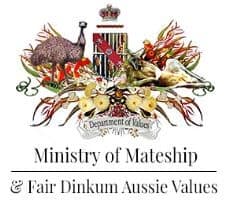Sorry
It is a pop-psych fallacy, particularly perpetrated by John Howard, to insist on “putting the past behind us”. The past that is not dealt with eats away at us in our (collective) subconscious and paralyses us for action. The past that is put behind us bites us in the bum.
What in the past is not acknowledged, and is not completed, waits for us in the future. The refusal of the non-aboriginal people of Australia to acknowledge the past has waited for us for a long time and has been draining our energy. It has stopped us from creating a different future, and not just in the area of indigenous affairs.
When the past is completed it is taken out of the future. The most powerful means of doing that is acknowledgement and apology.
What is left is a blank slate on which we can create anything we choose. Great adventures, great achievements, great excitement.
The removal of aboriginal children from their families is a past that today is to be completed with the simple word, “Sorry”, and that simple action will be the beginning of a future we are only beginning to imagine.
The removal policy was part of a eugenic strategy to fade out the aboriginal race – slowburn genocide, if you like. It was never “for their own good” but was targeted at particular types of children. Only aboriginal children were removed – specifically, only part-aboriginal children. “Full-bloods” were not removed but were left, in their racial degeneracy, to die out.
Absorption and Merger
“ Governments subsequently turned to alternative policies to protect Aborigines. In developing these policies, it appeared clear to all that the Aboriginal race was marching towards extinction.
John Forrest, Chair of the 1883 Commission established to inquire into the Aboriginal situation, reported that the Aborigines were “fast disappearing” and that “this was inevitable and usual among similar ethnic minorities in other parts of the world, and that Aborigines were a “vagrant race”, unresponsive to measures for amelioration of their conditions.”
Commentators of the England cricket tour of 1867-68 expressed regret that the “smart cricketers” (Aborigines who had learnt to play cricket) were members of “dying race” because it had been possible to raise some “above [their] natural level as “savage[s]”.
The social-Darwinist absorption or merger policies awaited the extinction of “full-blood” Indigenous persons. Social-Darwinists saw Aborigines as either the “missing link” or the subjects of degeneration, namely they were “man in a state of barbarism…inevitably and invariably [to go] downward towards extinction”. Social Darwinism predicted that the Aborigines would die out because of the laws of nature; namely, survival of the fittest. Biological determinism advocated an activist approach to this process calling for the pro-active breeding out of Aboriginal blood. This breeding out approach was based on the science of eugenics.
In the context of the Australian Aboriginals, the policy application of eugenic scientific theories was called “merger” or “absorption”. Eugenics propounded that the children with the fairest skin colour would be most likely to lose their Aboriginal identity and, accordingly, most readily absorbed into the non-Indigenous population. In contrast with the racial purification policies of Nazi Germany, it was argued that the White community should accept “half-caste” children once the children were sufficiently White in complexion during which time “full-bloods” would die out.
In a process that Smith refers to as “indigenisation”, the humanitarian discourse of protection turned to incorporating the Other into the settler community and thereby displacing the natives. The protectorate policies, it was thought, were doomed to fail because the Aborigines were a dying race. Something more was needed to protect individual members of the protected group.
By the 1890s, the NSW Board began to remove Indigenous children of mixed descent from their families and “merge” them into the non-Indigenous population. The term absorption was adopted in Western Australia.
Debate emerged throughout Australia regarding the best age at which the children should be removed so as to promote the efficacy of the merger policies. A 1913 Royal Commission in South Australia failed to determine whether the children should ideally be removed at birth or at the age of two years. The Queensland and Western Australian Chief Protectors deemed the age of four years as the preferred age of removal.
Murdoch University Electronic Journal of Law, “Genocide, a Crime of Which No Anglo-Saxon Nation Could be Guilty”, David Markovich BCom(Econ), LLB (Hons)”
Windschuttle¹ disagrees with all this, of course, which makes it pretty certainly correct.
Apologists claim that it was done for the good of the victims, or that in any event that was the result in many cases. The truth is that “the good of the children” was no consideration. Children were taken from their families solely on the basis of the colour of their skin – literally – and their family circumstances were immaterial.
It is impossible to imagine what reaction there would be if white children were systematically removed from their families in the way that aboriginal children were, even rounded up on horseback and torn away from their mothers as they were at one time. No government which carried out such a policy would survive even weeks. There would be rioting in the streets. The Aborigines, however, were powerless and no such redress was available to them.
Nor is it possible for most of us to imagine the anguish of entire families who grew up without their children or their grandchildren or their parents or their siblings; the desperation and despair of parents to find their children; the cultural amputation of children no longer permitted to speak their own language, to “be” aboriginal and yet to suffer the racial discrimination which they encountered, and still encounter. To characterise the deep damage inevitably caused by these outcomes as justified “for the children’s own good” is cultural and, worse, religious arrogance of the most abhorrent kind.
Then there is the excuse that “we” should not take the blame for what was done by others to other people, that this government cannot take the blame for what was done before. Most of those who formulated and carried out the policies of removing aboriginal children from their families are dead. But although they are dead the hurt and the social legacy are very much with us today. Secondly, this is not the government which passed the laws. Nevertheless governments are accountable in the way that individuals are. They have accountability in the way that corporations, as legal ‘persons’, do. A company which incurred a debt ten years ago still has that debt even though every one of the executives and every single employee has changed, and in fact even though none of the original shareholders remains. In an unbroken line that goes back to the beginning of the company, the new management and employees and shareholders still bear the company’s burdens. And so do we now. Not as blame, but we as a nation are accountable.
Ruby Langford Ginibi, author of Don’t Take Your Love to Town, said to me some years ago that as long as ordinary Australians are still reaping the benefits of the actions that were taken, even long ago, against the aboriginal people — including the theft of their land and their children — then if today’s beneficiaries do not acknowledge those wrongs they are as guilty as the original perpetrators. It is easy to see the truth in this.
We bear responsibility as a nation. Denial does not make us strong. It makes us weak. Acknowledging responsibility does not weaken or belittle us. On the contrary, taking responsibility makes us powerful. It gives us the power to take action, to make a difference, to complete the past and to cause a new future.
¹Another historian, Irving Candicocque, also disagrees, saying that
“Aborigines have always been well-looked after. They are allowed at least two hours a day in the exercise yard and their accommodation – at our expense! – includes their very own shit pan which is a great deal more than they used to have as savages in the bush!”
Candicocque’s works include
Denying the obvious (Our Grandfathers Could Never Have Did Nothing So Nasty Like What They Say),
The Aboriginal Protection Boards (They Never Stole No Kids and Anyway it Was for Their Own Good)
and The Great Big Massacre Hoax (they weren’t killed; they just ran away and never come back).





0 Comments